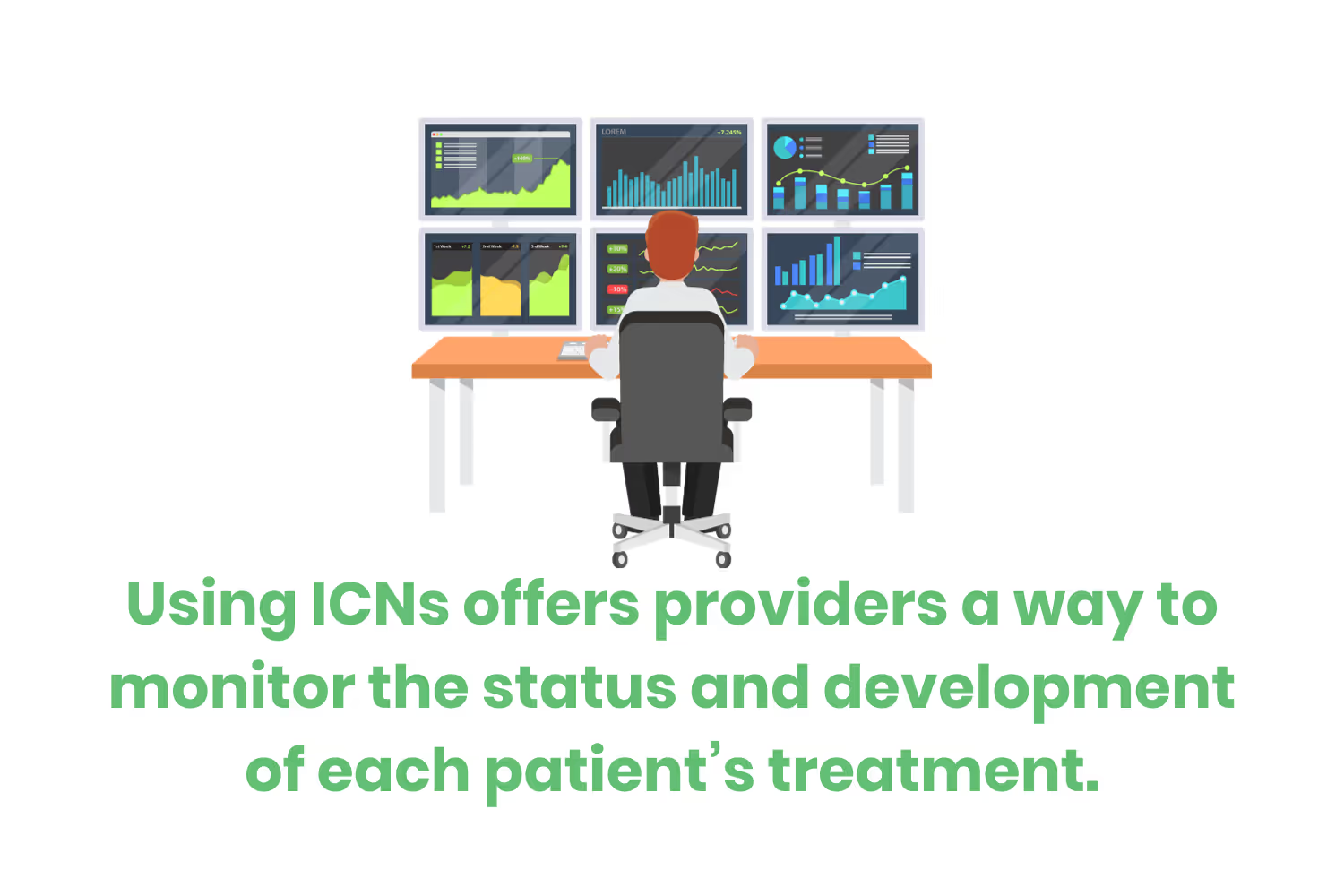The Ultimate Guide to Internal Control Numbers (ICN)
In this blog, explore what ICNs are, the benefits they provide, and best practices for managing them.

According to a KFF report, 2021 saw an increase of 17 percent in in-network claim denials. This percentage derives from complete data across all HealthCare.gov insurers.
However, average insurer denial rates can vary widely, depending on the payer and practice involved. The same KFF report explains that these rates can range from 2% to 49%.
If this all seems a bit complicated to you, don’t feel bad. Not many people can confidently say they understand everything about the medical billing and coding system. The intricacies of medical billing as a practice can be perplexing.
There are far too many numbers, rules, and codes to remember off of the top of your head. Even so, those numbers and codes are essential for running a streamlined revenue cycle management process.

So what can you do?
Make sure the data on the medical claim is complete, accurate, and thorough! Especially when handling denied medical claims. The last thing you want is to resubmit a claim only to have it come back rejected again.
Understanding what kind of data is necessary and where to place it on a claim can save you from avoidable denials.
One of the key pieces of data, that helps ensure your medical claim accuracy, happens to be the Internal Control Number (ICN). These tracking numbers assist medical billing professionals in streamlining the billing process, safeguarding financial transactions, and ensuring healthcare compliance.
In this blog, we will explore what ICNs are, the benefits they provide, and best practices for managing them.
What is an Internal Control Number (ICN)?
When talking about ICNs, I basically gave you a quick overview. At a very surface level, they act as tracking numbers. But, that doesn’t really tell you much of anything when it comes to the overall benefits they provide, so let’s dive into it more.
Insurance companies assign this 13-digit number to every medical claim processed by Medicare and Medicaid. By doing so, ICNs help keep track of provided services internally. This is especially helpful when resubmitting a void claim or adjusted/replacement claim.
This tracking mechanism helps facilitate the timely processing of claims. It also helps track billing transactions and offers a window to monitor the progress of claims. This is true throughout the entire reimbursement process.
No two ICNs are the same.
Each ICN is specific to a particular:
- Patient.
- Treatment.
- Billing Information.

These specifics ensure the billing process remains organized and transparent. You can find these numbers on the beneficiary line of the medical claim. ICNs may also appear on the claim as a Claim Control Number (CCN), as the two terms are interchangeable.
Let’s break down the 13-digit code and what each section means:
- Digits 1-2: Refer to how the provider submits the claim, either electronically or via paper.
- Digits 3-4: Refers to the calendar year of the received claim.
- Digits 5-7: The day of the year of the received claim.
- Digits 8-13: These are a distinctive set of numbers assigned to the claim by the Medicare contractor.
Let’s take a look at the following example, which will give you a clearer picture of how to read an ICN:
- 1121150351480
Because 2 and 1 make up the third and fourth numbers, you know that the provider submitted the claim in the year 2021. The fifth, sixth, and seventh digits (150) indicate the payer received the claim on the 150th day of the year. We can then understand from the ICN above, that Medicare received the claim on May 30th, 2021.
Veteran Internal Control Number
It’s important to note that providers who submit claims to the Department of Veteran Affairs (VA), Optum, or TriWest must use Veteran ICNs when applicable.
Each veteran ICN has 17 characters (10 digits + “V” + 6 digits) and serves the same purpose as a social security number.
However, community providers should use veteran ICN over SSN when submitting claims, unless otherwise required by law.

The VA assigns veteran ICNs. You can find them in the “Patient Details” section of Health Share Referral Manager (HSRM). They’re also sometimes found on the first page of VA Form 10-7080 (the offline referral form).
Using a Veteran’s unique ICN helps to:
- Enhance the security of their personal protected information.
- Simplify the claims process.
- Reduce the risk of rejected claims.
The Benefits of ICNs in Medical Billing
There are many benefits to utilizing an ICN, such as maintaining an accurate record of your billing transactions.
By having these specific sets of numbers for each claim, providers can trace the lifecycle of their claims and transactions. This reduces the likelihood of running into errors by ensuring the correct billing amounts find their way to the right patient and payer.

Here are a few other benefits ICNs provide:
- Facilitating Communication: When analyzing the communication between healthcare providers and payers, you might already be aware that the two entities don’t always see eye to eye. Sometimes, there can be details lost in translation, which makes for a confusing and even frustrating exchange. ICNs help simplify this discourse! Referencing an ICN takes away any confusion about whether the payer and provider are even discussing the same claim. Streamlining the resolution process is the name of the game when inquiries or clarification is necessary. Fewer requests are made to clarify or for extra information to resolve an issue means a faster reimbursement.
- Preventing Fraud and Abuse: Here’s something you might not know. ICNs are actually very important when it comes to detecting fraudulent activities. In billing discrepancies, ICNs offer healthcare organizations an insight into any irregular billing patterns. By having this tool, providers can ensure they meet compliance regulations. Not only this but collecting data on previous cases of fraud and abuse allows organizations to better prevent similar cases in the future.
- Improving Efficiency: Standardized reference points provided by ICNs contribute greatly to the efficiency of the medical billing process. Providers and payers are then able to quickly locate, update, and manage records if ever necessary. With an increased efficiency in this system, you can expect faster reimbursements as well as reduced administrative burdens. Healthcare staff can use this gathered data to make better decisions regarding initiatives to cut unnecessary costs and enhance their overall quality of service.
- Enhanced Patient Care: Speaking of enhancing the overall quality of service, this includes patient care as well. Using ICNs offers providers a way to monitor the status and development of each patient’s treatment. Helpful for spotting gaps in care and also spotting patterns in patient outcomes, ICNs make it easier for providers to access data. To be able to use this data to make more informed decisions regarding patient care offers a huge advantage to the healthcare system in battling chronic and acute cases. ICNs also offer a platform for providers to revisit while tending to their patients, offering a more personal and direct approach to their practice. This immediate familiarity with a case helps encourage honest dialogue between provider and patient.
Best Practices for Managing ICNs
When managing ICNs, you’re going to want to remember a few key best practices.
For instance, I would say one of the most important things to remember is to thoroughly document these ICNs alongside patient records. Maintaining accurate record-keeping lets you rest easy knowing that if you need to pull up a particular claim, you know exactly where to find it.
Another hot tip is to make sure you regularly reconcile ICNs with your billing records. This is to identify any discrepancies, and therefore get ahead of the game if adjustments are necessary. Being able to promptly and preemptively handle inconsistencies in billing records will save you from a headache down the road. Double-checking your work is never a bad idea!

Make sure your staff is familiar with ICN practices, as well as their significance in a smooth running revenue cycle. Human error is an all too common occurrence in medical billing, so a well-trained staff is an incredibly helpful tool to keep in your belt.
Finally, automation also reduces the likelihood of human errors. Consider investing in a billing software service that helps manage your ICNs. Doing so will save your staff from tedious work while also enhancing your overall efficiency as an organization.
Conclusion
Internal Control Numbers are the unsung heroes of the medical billing community.
Maybe that’s a bit dramatic for me to say, but they truly are an important factor in getting your reimbursements on time! Not to mention, making sure you get the right amount. One of their many roles is (after all) to ensure accuracy and prevent fraud.
Providers and billing professionals alike should recognize the significance of ICNs in order to cultivate the best financial outcome. Being able to streamline the billing process, minimize errors, and optimize financial outcomes, only strengthens the financial health of all parties involved in the cycle.
Emphasize your product's unique features or benefits to differentiate it from competitors
In nec dictum adipiscing pharetra enim etiam scelerisque dolor purus ipsum egestas cursus vulputate arcu egestas ut eu sed mollis consectetur mattis pharetra curabitur et maecenas in mattis fames consectetur ipsum quis risus mauris aliquam ornare nisl purus at ipsum nulla accumsan consectetur vestibulum suspendisse aliquam condimentum scelerisque lacinia pellentesque vestibulum condimentum turpis ligula pharetra dictum sapien facilisis sapien at sagittis et cursus congue.
- Pharetra curabitur et maecenas in mattis fames consectetur ipsum quis risus.
- Justo urna nisi auctor consequat consectetur dolor lectus blandit.
- Eget egestas volutpat lacinia vestibulum vitae mattis hendrerit.
- Ornare elit odio tellus orci bibendum dictum id sem congue enim amet diam.
Incorporate statistics or specific numbers to highlight the effectiveness or popularity of your offering
Convallis pellentesque ullamcorper sapien sed tristique fermentum proin amet quam tincidunt feugiat vitae neque quisque odio ut pellentesque ac mauris eget lectus. Pretium arcu turpis lacus sapien sit at eu sapien duis magna nunc nibh nam non ut nibh ultrices ultrices elementum egestas enim nisl sed cursus pellentesque sit dignissim enim euismod sit et convallis sed pelis viverra quam at nisl sit pharetra enim nisl nec vestibulum posuere in volutpat sed blandit neque risus.

Use time-sensitive language to encourage immediate action, such as "Limited Time Offer
Feugiat vitae neque quisque odio ut pellentesque ac mauris eget lectus. Pretium arcu turpis lacus sapien sit at eu sapien duis magna nunc nibh nam non ut nibh ultrices ultrices elementum egestas enim nisl sed cursus pellentesque sit dignissim enim euismod sit et convallis sed pelis viverra quam at nisl sit pharetra enim nisl nec vestibulum posuere in volutpat sed blandit neque risus.
- Pharetra curabitur et maecenas in mattis fames consectetur ipsum quis risus.
- Justo urna nisi auctor consequat consectetur dolor lectus blandit.
- Eget egestas volutpat lacinia vestibulum vitae mattis hendrerit.
- Ornare elit odio tellus orci bibendum dictum id sem congue enim amet diam.
Address customer pain points directly by showing how your product solves their problems
Feugiat vitae neque quisque odio ut pellentesque ac mauris eget lectus. Pretium arcu turpis lacus sapien sit at eu sapien duis magna nunc nibh nam non ut nibh ultrices ultrices elementum egestas enim nisl sed cursus pellentesque sit dignissim enim euismod sit et convallis sed pelis viverra quam at nisl sit pharetra enim nisl nec vestibulum posuere in volutpat sed blandit neque risus.
Vel etiam vel amet aenean eget in habitasse nunc duis tellus sem turpis risus aliquam ac volutpat tellus eu faucibus ullamcorper.
Tailor titles to your ideal customer segment using phrases like "Designed for Busy Professionals
Sed pretium id nibh id sit felis vitae volutpat volutpat adipiscing at sodales neque lectus mi phasellus commodo at elit suspendisse ornare faucibus lectus purus viverra in nec aliquet commodo et sed sed nisi tempor mi pellentesque arcu viverra pretium duis enim vulputate dignissim etiam ultrices vitae neque urna proin nibh diam turpis augue lacus.




